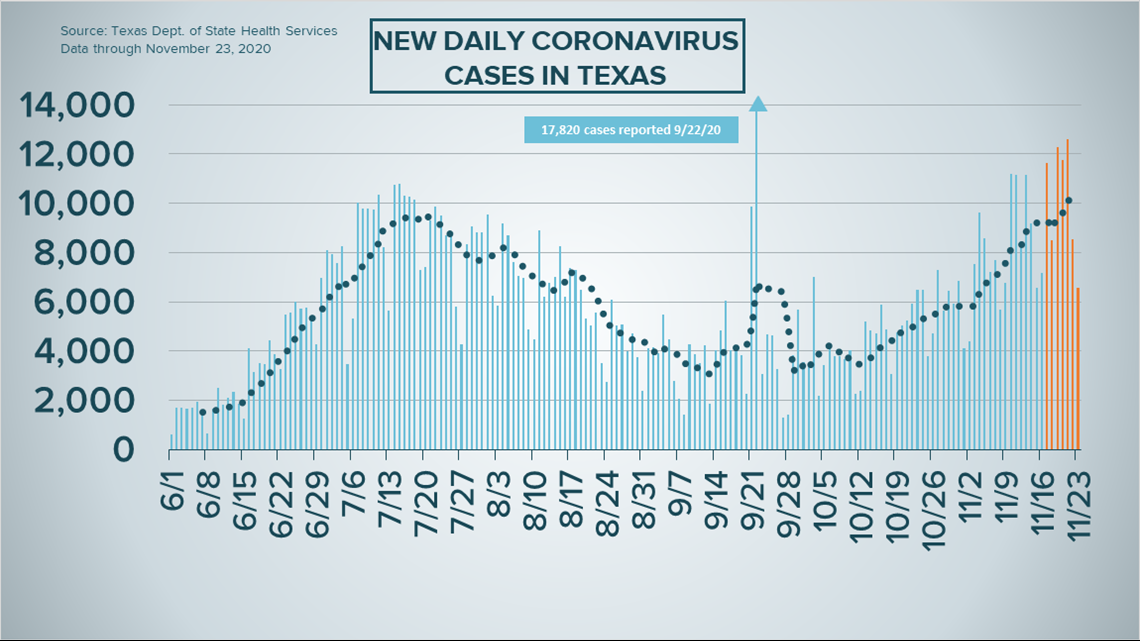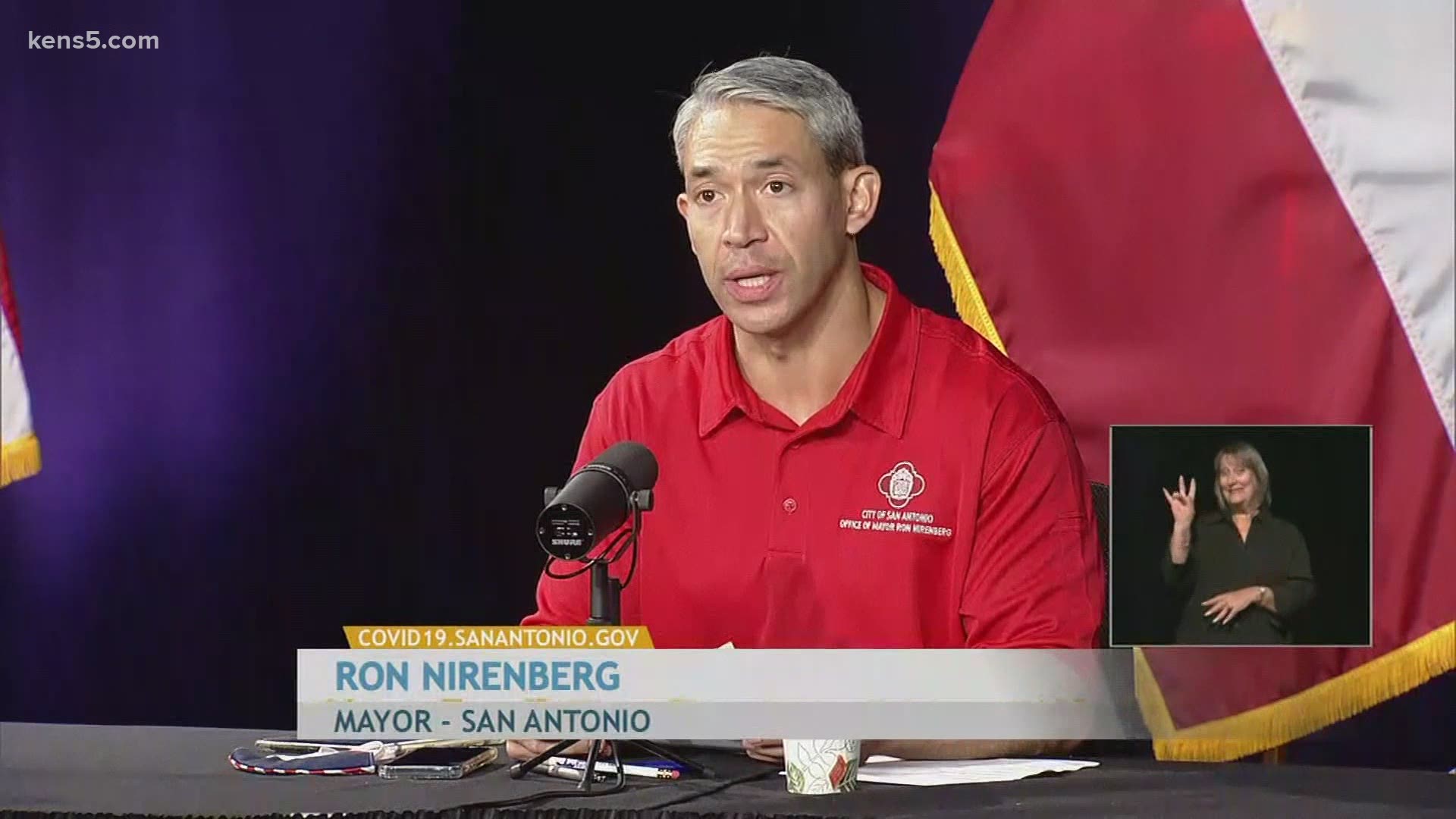SAN ANTONIO — We're tracking the latest numbers from the coronavirus pandemic in San Antonio and across Texas. Here are the latest numbers reported by Bexar and surrounding counties:
- Bexar County: 709 new cases were reported Monday, bringing the total number of cases to 75,591. No new deaths were reported, so the death toll remains at 1,335.
- Comal County: The county reported 20 new COVID-19 cases Monday and no new virus-related deaths. There have been a total of 4,358 reported cases of COVID-19 in the county – including 3,125 lab-confirmed cases – while 125 county residents have died. County officials say there are 401 active coronavirus cases, and 3,832 residents are considered recovered.
- Hays County: Officials in Hays County on Monday reported 82 new cases in the county and three additional COVID-related fatalities. As of Monday, there are a total of 7,042 lab-confirmed cases in the county (735 of which are active), while the death toll rose to 99. 6,208 residents have recovered from the virus.
More county case information is available through the Texas Department of Health Services COVID-19 dashboard.
How Bexar County is trending
We've tracked how many coronavirus cases have been confirmed in Bexar County from the time officials began reporting cases in March 2020. The graphic below shows the number of cases since June and charts those daily case numbers along a 7-day moving average to provide a more accurate picture of the overall coronavirus case curve in our area and the direction we're trending amid the pandemic.
Mayor Nirenberg reported 709 new cases Monday, bringing the total number of cases to 75,591.


The City updated their coronavirus numbers, revealing the weekly positivity rate has increased to 10%, which the county classifies as severe. Last Tuesday, the Community Response Coalition recommended Bexar County Judge Nelson Wolff to close bars if the COVID-19 community percent positivity is equal to or exceeds 10% for two consecutive weeks. Prior to the recommendation, Bexar County was at a 9.4% coronavirus positivity rate.
Metro Health urged San Antonians to avoid indoor gatherings with people outside of your immediate family.
"If you don't heed the warnings this Thanksgiving holiday, you or your loved ones could be spending Christmas in the hospital," Nirenberg said
No new deaths were reported, so the death toll remains at 1,335.
Hospitalizations continued a troubling trend and rose by 17 Monday, all the way up to 509 patients currently in area hospitals. Of those, 80 are on ventilators and 171 are in intensive care.


Coronavirus in Texas
The total number of novel coronavirus cases in the state since the pandemic began grew by 6,704 on Monday according to the Texas Department of State Health Services, including 6,576 new cases. The rest are cases attributed to backlogs that were previously not included in the state's total. (More details can be found at the top of this page.)
As of Monday, 1.1 million Texans have contracted COVID-19.


State health authorities also reported 32 additional virus-related deaths on Monday. At least 20,588 Texans have died from COVID-19 complications.
The number of COVID-19-related hospital patients jumped by 179 on Monday up to 8,353, the highest it has been since August 5.
Since the start of October, the number of Texas hospitalizations has increased by 162%. Meanwhile, the state estimates that 917,739 Texans have recovered, while 165,126 Texans remain ill with COVID-19.
Meanwhile, the latest update from the Texas Education Agency showed that there have been 50,420 cumulative cases among staff and students across the state through Nov. 15. More information can be found here.
The TEA releases new data on school cases every Thursday.
Latest Coronavirus Headlines
- More than 130 Texas counties are currently at COVID-19 risk 'tipping point,' data shows
- 'Please pray' | HPD officer hospitalized with COVID-19 in dire condition, chief says
- White House to hold holiday parties despite warnings to Americans to avoid them
- Poll: 1 in 3 parents say Thanksgiving gatherings worth COVID-19 risk
- El Paso offered $27 an hour for help moving bodies of COVID victims at overwhelmed morgue
- Sunday was busiest air travel day since March, despite pleas to stay home
- AstraZeneca: COVID-19 vaccine 'highly effective' prevention
Coronavirus symptoms
The symptoms of coronavirus can be similar to the flu or a bad cold. Symptoms include fever or chills, cough, shortness of breath or difficulty breathing, fatigue, muscle or body aches, headache, new loss of taste or smell sore throat, congestion or runny nose, nausea or vomiting and diarrhea, according to the Centers for Disease Control.
Most healthy people will have mild symptoms. A study of more than 72,000 patients by the Centers for Disease Control in China showed 80 percent of the cases there were mild.
But infections can cause pneumonia, severe acute respiratory syndrome, kidney failure, and even death, according to the World Health Organization. Older people with underlying health conditions are most at risk.
But infections can cause pneumonia, severe acute respiratory syndrome, kidney failure, and even death, according to the World Health Organization. Older people with underlying health conditions are most at risk.
Experts determined there was consistent evidence these conditions increase a person's risk, regardless of age:
- Chronic kidney disease
- COPD (chronic obstructive pulmonary disease)
- Obesity (BMI of 30 or higher)
- Immunocompromised state (weakened immune system) from solid organ transplant
- Serious heart conditions, such as heart failure, coronary artery disease, or cardiomyopathies
- Sickle cell disease
- Type 2 diabetes
The CDC believes symptoms may appear anywhere from two to 14 days after being exposed.
Human coronaviruses are usually spread...
- Between people who are in close contact with one another (within about 6 feet).
- Through respiratory droplets produced when an infected person coughs, sneezes or talks. These droplets can land in the mouths or noses of people who are nearby or possibly be inhaled into the lungs.
- Some recent studies have suggested that COVID-19 may be spread by people who are not showing symptoms.
Help stop the spread of coronavirus
- Stay home when you are sick.
- Eat and sleep separately from your family members
- Use different utensils and dishes
- Cover your cough or sneeze with your arm, not your hand.
- If you use a tissue, throw it in the trash

